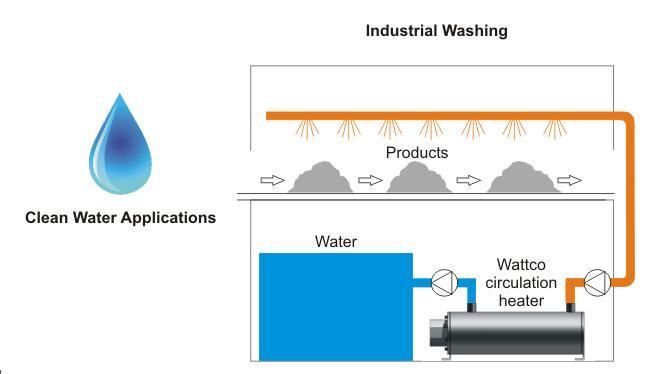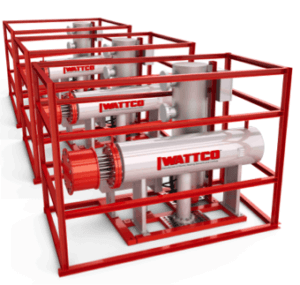Circulation Heaters for Clean Water Heating Applications
WATTCO delivers a wide range of circulation heaters for the industrial process heating industry. The salient feature of the Wattco circulation heater is a cylindrical-shaped container/vessel with heating element inside.
One important application of circulation heaters is to heat clean water, for example, as required for industrial washing (see Figure 1.)

Figure 1
Construction and Operation
Circulation heaters (also called inline heaters) are designed for indirect heating. Flanged immersion heaters are mounted in a thermally-insulated chamber/vessel for efficient heating of a flowing medium. These circulation heaters consist of inlet and outlet nozzles that allow the fluid (for example, municipal water) to enter and exit the circulation heaters.
For water application, the user can choose from a wide range of flange and sheath materials, wattage, power (kilowatts) ratings and the size(s) of the vessel.
One important application of circulation heaters is to heat clean water, for example, as required for industrial washing (see Figure 1.)

Figure 1
Construction and Operation
Circulation heaters (also called inline heaters) are designed for indirect heating. Flanged immersion heaters are mounted in a thermally-insulated chamber/vessel for efficient heating of a flowing medium. These circulation heaters consist of inlet and outlet nozzles that allow the fluid (for example, municipal water) to enter and exit the circulation heaters.
For water application, the user can choose from a wide range of flange and sheath materials, wattage, power (kilowatts) ratings and the size(s) of the vessel.
| Applications | Sheath | Flange |
|---|---|---|
| Clean water for freeze protection Water heaters for steam generation |
Copper | Steel |
| Food washing | Incoloy® | Stainless Steel |
To use the circulation heater in clean water application, the user must use a pump to transport the fluid inside the circulation system. The heating element provides the heat to the water as it flows inside the chamber. For proper heating, the water should enter the circulation heater through the inlet which is near the flange immersion heater. As the water flows through the vessel, the desired temperature of water is reached. Water then comes out of the chamber via the outlet nozzle.
Circulation heaters come with two types of mounting: horizontal and vertical.
One very useful feature of these circulation heaters is the drain valve. It can be installed anywhere in the vessel. It allows purging of water, facilitating easy maintenance, when needed.
In circulation heaters, there are thermocouple probes or thermostats to control the water temperature to the desired level.
There are different types of terminal boxes for circulation heaters. Since water is used as the fluid medium, a basic terminal box is sufficient.
Selecting the proper circulation heater

For water application, the selection of circulation heater will depend on:
· Flow rate of the water
· Watt/area specification of the heating element (sheath material)
You can also choose the mounting (horizontal or vertical) type, depending on the physical space that you have available.
Benefits
Circulation heaters are capable of transferring heat very efficiently to the fluid medium. Since the heating is done at a different chamber/vessel, it is an ideal choice for a wide range of fluids (both liquid and gas). Circulation heaters allow easy maintenance for servicing or replacing heating elements (rods). There is no need to drain the fluid from the fluid container.
Frequently Asked Questions
Q1: Why are circulation heaters called “inline heaters”?
Circulation heaters are also called inline heaters because the shape of the heater, the way the heating element is mounted, and the way the fluid is circulated inside the vessel.
Q2: Which parameter is very important for choosing the wattage requirement for circulation heaters?
The flow rate of the fluid in gallons per minute (GPM) is an important parameter that the user must consider before selecting the correct circulation heater.
Circulation heaters for clean water heating application
WATTCO delivers a wide range of circulation heaters for the industrial process heating industry. The salient feature of the Wattco circulation heater is a cylindrical-shaped container/vessel with heating element inside.
One important application of circulation heaters is to heat clean water, for example, as required for industrial washing (see Figure 1.)
Figure 1
Construction and Operation
Circulation heaters (also called inline heaters) are designed for indirect heating. Flanged immersion heaters are mounted in a thermally-insulated chamber/vessel for efficient heating of a flowing medium. These circulation heaters consist of inlet and outlet nozzles that allow the fluid (for example, municipal water) to enter and exit the circulation heaters.
For water application, the user can choose from a wide range of flange and sheath materials, wattage, power (kilowatts) ratings and the size(s) of the vessel.
| Applications | Sheath | Flange |
|---|---|---|
| Clean water for freeze protection Water heaters for steam generation |
Copper | Steel |
| Food washing | Incoloy® | Stainless Steel |
To use the circulation heater in clean water application, the user must use a pump to transport the fluid inside the circulation system. The heating element provides the heat to the water as it flows inside the chamber. For proper heating, the water should enter the circulation heater through the inlet which is near the flange immersion heater. As the water flows through the vessel, the desired temperature of water is reached. Water then comes out of the chamber via the outlet nozzle.
Circulation heaters come with two types of mounting: horizontal and vertical.
One very useful feature of these circulation heaters is the drain valve. It can be installed anywhere in the vessel. It allows purging of water, facilitating easy maintenance, when needed.
In circulation heaters, there are thermocouple probes or thermostats to control the water temperature to the desired level.
There are different types of terminal boxes for circulation heaters. Since water is used as the fluid medium, a basic terminal box is sufficient.
Selecting the proper circulation heater
For water application, the selection of circulation heater will depend on:
· Flow rate of the water
· Watt/area specification of the heating element (sheath material)
You can also choose the mounting (horizontal or vertical) type, depending on the physical space that you have available.
Benefits
Circulation heaters are capable of transferring heat very efficiently to the fluid medium. Since the heating is done at a different chamber/vessel, it is an ideal choice for a wide range of fluids (both liquid and gas). Circulation heaters allow easy maintenance for servicing or replacing heating elements (rods). There is no need to drain the fluid from the fluid container.
Frequently Asked Questions
Q1: Why are circulation heaters called “inline heaters”?
Circulation heaters are also called inline heaters because the shape of the heater, the way the heating element is mounted, and the way the fluid is circulated inside the vessel.
Q2: Which parameter is very important for choosing the wattage requirement for circulation heaters?
The flow rate of the fluid in gallons per minute (GPM) is an important parameter that the user must consider before selecting the correct circulation heater.
